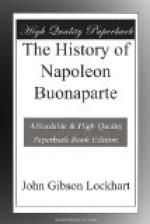Either leader claimed the victory; Bennigsen exhibiting as proof of his success the twelve eagles which his army, admitted to be inferior in numbers, bore off the field: Buonaparte, that he kept possession of the field, while the enemy retired, the very night after the battle, from Eylau towards Konigsberg. It was, in truth, a drawn battle; and to have found an equal was sufficient bitterness to Napoleon. The Russian general-in-chief had retreated, in opposition to the opinion of most of his council, out of anxiety for the personal safety of the King of Prussia at Konigsberg, and desire to recruit his army ere another great action should be hazarded. The French, triumphant as was the language of their bulletins, made no effort to pursue. Bennigsen conducted his army in perfect order to Konigsberg, and the Cossacks issuing from that city continued for more than a week to waste the country according to their pleasure, without any show of opposition from the French. But the best proof how severely Napoleon had felt the struggle of Preuss-Eylau, is to be found in a communication which he made to Frederick William, on the 13th of February, five days after the battle, offering him, in effect, the complete, or nearly complete restoration of his dominions, provided he would accept of a separate peace: with the king’s answer; namely, that it was impossible for him to enter on any treaty unless the Czar were a party in it. Finally, on the 19th of February, Napoleon left Eylau, and retreated with his whole army on the Vistula; satisfied that it would be fatal rashness to engage in another campaign in Poland, while several fortified towns, and, above all, Dantzick, held out in his rear; and determined to have possession of these places, and to summon new forces from France, ere he should again meet in the field such an enemy as the Russian had proved to be.




